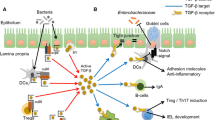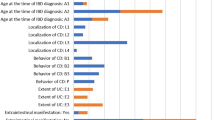Abstract
Ulcerative colitis is a chronic inflammatory disease of colonic mucosa in which the pathogenesis of any immunological disorders would likely be related. Various circulating autoantibodies have been reported in patients with ulcerative colitis, although their possible roles in this disease process have not yet been clarified. Autoantibody against hepatoma-derived growth factor (HDGF) was detected at high frequency in the serum of patients with ulcerative colitis, especially in patients with total colitis and left-sided colitis. In pursuit of the possible role of anti-HDGF autoantibody in the pathogenesis, we investigated HDGF expression in the intestinal mucosa by Western blotting and immunohis-tochemistry and the effects of recombinant proteins and antirecombinant HDGF antibody on the proliferation of the colonic epithelial cell-derived cell line, HT-29. HDGF was expressed in the nucleus of the colonic epithelial cells dominantly in the bottom of the crypts. Recombinant HDGF stimulated the proliferation of HT-29 cells significantly, although its effects were small, about 20% greater than the control at 100ng/ml. On the other hand, the polyclonal IgG antibody against recombinant HDGF generated by rabbits suppressed their proliferation almost completely at 250 μg/ml. These findings suggest that HDGF plays an important role in epithelial cell renewal of intestinal crypts as a growth and survival factor, and that autoantibody against HDGF may delay mucosal healing and repair by inhibiting the stimulatory effects of HDGF on epithelial cell proliferation, resulting in a chronic process of colonic mucosal injury.
Similar content being viewed by others
References
Nagai T, Das KM. Demonstration of an assay for specific cytolitic antibody in sera from patients with ulcerative colitis. Gastroenterology 1981;80:1507–12.
Nagai T, Das KM. Detection of colonic antigen(s) in tissues from ulcerative colitis using purified colitis colon tissue-bound IgG (CCA-IgG). Gastroenterology 1981;81:463–70.
Takahashi F, Das KM. Isolation and characterization of a colonic autoantigen specifically recognized by colon tissue-bound immunoglobulin G from idiopathic ulcerative colitis. J Clin Investig 1985;76:311–8.
Saxon A, Shanahan F, Landers C, Ganz T, Targan S. A distinct subset of antineutrophil cytoplasmic antibodies is associated with inflammatory bowel disease. J Allergy Clin Immunol 1990;86:202–10.
Rump JA, Worner I, Roth M, Scholmerich J, Hansch M, Peter HH. P-ANCA of undefined specificity in ulcerative colitis: correlation to disease activity and therapy. Adv Exp Med Biol 1993;336:507–13.
Bansi DS, Fleming KA, Chapman RW. Importance of antineutrophil cytoplasmic antibodies in primary sclerosing cholangitis and ulcerative colitis: prevalence, titre, and IgG subclass. Gut 1996;38:384–9.
Frenzer A, Fierz W, Rundler E, Hammer B, Binek J. Atypical, cytoplasmic and perinuclear anti-neutrophil cytoplasmic antibodies in patients with inflammatory bowel disease. J Gastroenterol Hepatol 1998;13:950–4.
Sobajima J, Ozaki S, Uesugi H, Osakada F, Shirakawa H, Yoshida M, et al. Prevalence and characterization of perinuclear antineutrophil cytoplasmic antibodies (P-ANCA) directed agaisnt HMG1 and HMG2 in ulcerative colitis (UC). Clin Exp Immunol 1998;111:402–7.
Das KM, Dasgupta A, Mandai A, Geng X. Autoimmunity to cytoskeletal protein tropomyosin. A clue to the pathogenetic mechanism for ulcerative colitis. J Immunol 1993; 150:2487–93.
Onuma EK, Amenta PS, Ramaswamy K, Lin JJ, Das KM. Autoimmunity in ulcerative colitis (UC): a predominant colonic mucosal B cell response against human tropomyosin isoform 5. Clin Exp Immunol 2000;121:466–71.
Sakamaki S, Takayanagi N, Yoshizaki N, Hayashi S, Takayama T, Kato J, et al. Autoantibodies against the specific epitope of human tropomyosin(s) detected by peptide based enzyme immunoassay in sera of patients with ulcerative colitis show antibody dependent cell mediated cytotoxicity against HLA-DPw9 transfected L cells. Gut 2000;47:236–41.
Nakamura H, Izumoto Y, Kambe H, Kuroda T, Mori T, Kawamura K, et al. Molecular cloning of complementary DNA for a novel human hepatoma-derived growth factor. Its homology with high mobility group-1 protein. J Biol Chem 1994;269:25143–9.
Izumoto Y, Kuroda T, Harada H, Kishimoto T, Nakamura H. Hepatoma-derived growth factor belongs to a gene family in mice showing significant homology in the amino terminus. Biochem Biophys Res Commun 1997;238:26–32.
Nakamura H, Kambe H, Egawa T, Kimura Y, Ito H, Hayashi E, et al. Partial purification and characterization of hepatomaderived growth factor. Clin Chim Acta 1989;183:273–84.
Oliver JA, Al-Awqati Q. An endothelial growth factor involved in rat renal development. J Clin Investig 1998;102:1208–19.
Everett AD, Lobe DR, Matsumura ME, Nakamura H, McNamara CA. Hepatoma-derived growth factor stimulates smooth muscle cell growth and is expressed in vascular development. J Clin Investig 2000;105:567–75.
Kishima Y, Yoshida K, Enomoto H, Yamamoto M, Kuroda T, Okuda Y, et al. Antisense oligonucleotides of hepatoma-derived growth factor (HDGF) suppress the proliferation of hepatoma cells. Hepato-Gastroenterology 2002 (in press).
Ikegame K, Yamamoto M, Kuroda T, Kishima Y, Enomoto H, Yoshida K, et al. A new member of a hepatoma-derived growth factor gene family can translocate to the nucleus. Biochem Biophys Res Commun 1999;266:81–7.
Kishima Y, Yamamoto H, Izumoto Y, Yoshida K, Enomoto H, Yamamoto M, et al. Hepatoma-derived growth factor stimulates cell growth after translocation to the nucleus by nuclear localization signals. J Biol Chem2002;277:10315–22.
Merenmies J, Pihlaskari R, Laitinen J, Wartiovaara J, Rauvala H. 30-kDa heparin-binding protein of brain (amphoterin) involved in neurite outgrowth. Amino acid sequence and localization in the filopodia of the advancing plasma membrane. J Biol Chem 1991;266:16722–9.
Huttunen HJ, Kuja-Panula J, Sorci G, Agneletti AL, Donato R, Rauvala H. Coregulation of neurite outgrowth and cell survival by amphoterin and S100 proteins through receptor for advanced glycation end products (RAGE) activation. J Biol Chem 2000; 275:40096–105.
Fages C, Nolo R, Huttunen HJ, Eskelinen E, Rauvala H. Regulation of cell migration by amphoterin. J Cell Sci 2000;113:611–20.
Burgess WH, Maciag T. The heparin-binding (fibroblast) growth factor family of proteins. Annu Rev Biochem 1989;58:575–606.
Ornits DM, Itoh N. Fibroblast growth factors. Genome Biol 2001; 2:3005.1–12.
Singh DP, Ohguro N, Kikuchi T, Sueno T, Reddy VN, Yuge K, et al. Lens epithelial-derived growth factor: effects on growth and survival of lens epithelial cells, keratinocytes, and fibroblasts. Biochem Biophys Res Commun 2000;267:373–81.
Johnson GR, Saeki T, Gordon AW, Shoyab M, Salomon DS, Stromberg K. Autocrine action of amphiregulin in a colon carcinoma cell line and immunocytochemical localization of amphiregulin in human colon. J Cell Biol 1992;118:741–51.
Kimura H. Schwannoma-derived growth factor must be transported into the nucleus to exert its mitogenic activity. Proc Natl Acad Sci USA 1993;90:2165–9.
Moroianu J, Riordan JF. Nuclear translocation of angiogenin in proliferating endothelial cells is essential to its angiogenic activity. Proc Natl Acad Sci USA 1994;91:1677–81.
Bajetto A, Schettini G, Chimini G. Nuclear localization of ciliary neurotrophic factor in glial cells. Brain Res 1999;818:565–9.
Author information
Authors and Affiliations
Rights and permissions
About this article
Cite this article
Nakamura, H., Yoshida, K., Ikegame, K. et al. Antibodies against hepatoma-derived growth factor and mucosal repair in ulcerative colitis. J Gastroenterol 37 (Suppl 14), 8–14 (2002). https://doi.org/10.1007/BF03326407
Published:
Issue Date:
DOI: https://doi.org/10.1007/BF03326407




